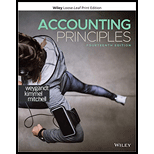
(a)
Accounting cycle: The accounting cycle refers to the process of recording and summarizing the financial events of a business. It operates in the form of a cycle, with the steps of accounting activities followed in a cyclical order. The cyclical order starts at the beginning of a transaction, until the time when financial results are derived subsequent to the preparation of the
To determine: Whether the steps in the accounting cycle for a merchandising company are different from the accounting cycle for a service company or not.
(a)
Explanation of Solution
The accounting cycle of a merchandising company is quite different from the accounting cycle of a service company. In a merchandising company, the process of purchasing merchandise inventory and the final process of selling extends the time period of the cycle. This may lead to a need for making quantity records for all purchases and sales. However, this is not true in the case of a service company.
A merchandising company undergoes more steps in the process of accounting. It is involved in selling products. So, the company is ought to take into consideration sales, including sales returns and allowances, and sales discounts. It would also have to consider purchases, including purchase returns and allowances and purchase discounts. The company would also have to consider ending inventory and cost of goods sold to evaluate the net profit. In a service company, the net profit is determined with the help of service revenue and operating expenses.
A service company provides services to its customers. This indicates that there would be no effect of sales, purchases, and cost of goods sold. The bulk of costs would involve labor costs.
The
Hence, it is agreeable that the steps in the accounting cycle for a merchandising company are different from the accounting cycle for a service company or not.
(b)
Whether the measurement of net income for a merchandising company is the same as that of a service company.
(b)
Explanation of Solution
The method of computing the net income in a merchandising company is different when compared to the method of computing the net income in a service company.
In a merchandising company, the net income is calculated as below.
| Particulars | Amount ($) | Amount ($) |
| Sales revenue | xxx | |
| Less: Cost of goods sold | xxx | |
| Gross profit | xxx | |
| Less: Operating expenses | xxx | |
| Selling expenses | xxx | |
| Administrative and general expenses | xxx | |
| Total operating expenses | xxx | |
| Net income | xxx |
Table (1)
In a service company, the net income is calculated below.
| Particulars | Amount ($) | Amount ($) |
| Service revenue | xxx | |
| Operating expenses: | ||
| Salary expenses | xxx | |
| |
xxx | |
| Income tax expenses | xxx | |
| Net income | xxx |
Table (2)
Hence, it can be concluded from Table (1) and Table (2) that the measurement of net income for a merchandising company is different from that of a service company.
Want to see more full solutions like this?
Chapter 5 Solutions
ACCT.PRINCIPLES (LL)-PACKAGE
- Parker Enterprises applies manufacturing overhead costs to products at a budgeted indirect-cost rate of $90 per direct manufacturing labor hour. A wholesale distributor has requested a bid on a special order of the Model Train product. Estimates for this order include direct materials of $82,000, 750 direct manufacturing labor hours at $45 per hour, and a 25% markup rate on total manufacturing costs. Manufacturing overhead cost estimates for this special-order total: a) $67,500 b) $58,500 c) $70,000 d) $78,250arrow_forwardI am looking for a step-by-step explanation of this financial accounting problem with correct standards.arrow_forwardBenevolent Professor Martin Company has an overhead cost pool for inspecting. The expected overhead cost is $420,000, and the estimated number of inspections is 15,000. The activity-based overhead rate (ABOR) used to assign the costs of the inspecting cost pool to products is __. Don't Use Aiarrow_forward
- Can you help me solve this financial accounting question using the correct financial procedures?arrow_forwardCan you explain the correct methodology to solve this general accounting problem?arrow_forwardI am searching for the correct answer to this financial accounting problem with proper accounting rules.arrow_forward
- Dormer Corporation has a forklift that is being sold after 3years of use. The current book value of the forklift is $7,200. If Dormer Corporation sells the forklift for $5,800, what is the impact of this transaction?arrow_forwardNeed answerarrow_forwardPlease explain the correct approach for solving this general accounting question.arrow_forward

 AccountingAccountingISBN:9781337272094Author:WARREN, Carl S., Reeve, James M., Duchac, Jonathan E.Publisher:Cengage Learning,
AccountingAccountingISBN:9781337272094Author:WARREN, Carl S., Reeve, James M., Duchac, Jonathan E.Publisher:Cengage Learning, Accounting Information SystemsAccountingISBN:9781337619202Author:Hall, James A.Publisher:Cengage Learning,
Accounting Information SystemsAccountingISBN:9781337619202Author:Hall, James A.Publisher:Cengage Learning, Horngren's Cost Accounting: A Managerial Emphasis...AccountingISBN:9780134475585Author:Srikant M. Datar, Madhav V. RajanPublisher:PEARSON
Horngren's Cost Accounting: A Managerial Emphasis...AccountingISBN:9780134475585Author:Srikant M. Datar, Madhav V. RajanPublisher:PEARSON Intermediate AccountingAccountingISBN:9781259722660Author:J. David Spiceland, Mark W. Nelson, Wayne M ThomasPublisher:McGraw-Hill Education
Intermediate AccountingAccountingISBN:9781259722660Author:J. David Spiceland, Mark W. Nelson, Wayne M ThomasPublisher:McGraw-Hill Education Financial and Managerial AccountingAccountingISBN:9781259726705Author:John J Wild, Ken W. Shaw, Barbara Chiappetta Fundamental Accounting PrinciplesPublisher:McGraw-Hill Education
Financial and Managerial AccountingAccountingISBN:9781259726705Author:John J Wild, Ken W. Shaw, Barbara Chiappetta Fundamental Accounting PrinciplesPublisher:McGraw-Hill Education





